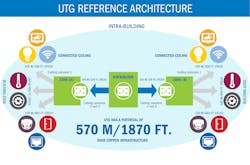The Evolution of Cabling Meets Expanding Technology Demands
The Transformation of Commercial Buildings
Commercial buildings are on the front lines of rapid technology evolution. The imminent arrival of 5G and the estimated 30 billion connected devices (2) that the Internet of Things (IoT) will enable in the next few years, as well as the presently unknown innovations and inventions that will place additional demands on bandwidth, are all driving transformation in buildings and businesses.Another change placing further demands on building networks is the move from “building security” to “building safety.” This subtle but significant shift is happening as businesses must encompass not only traditional physical security systems, including door locking hardware, access control, alarms and video surveillance, but must also implement and manage health and safety monitoring systems such as temperature checks, social distancing measures and room occupancy rates. With new technologies being regularly introduced, there is a pressing need to not just meet new and existing requirements but to plan how to support new systems well into the future.
With transformation this swift, an advanced infrastructure layer is essential to enable connectivity for evolving and new technologies, as well as provide flexibility for future elements we don’t yet know about.
The essence of seamless connectivity for building automation and controls, and the convergence of IT and OT applications across a common platform, is viewing data communications as a utility — The Fourth Utility. This isn’t a novel concept, it’s been around for at least 15 years, but looking at information as a utility has never been more relevant. In the past, some have claimed that various services or products are the Fourth Utility, while others say the Fourth Utility encompasses the entire network infrastructure.
In reality, it is a concept; an approach to digital transformation that will help to meet essential business challenges and goals. It highlights the reality that today, intelligence and information collected from connected devices is now as important as gas, water and electricity.
The convergence points for these connected devices lie within commercial buildings. Convergence is nothing new — what began as a single network to support voice and data grew to support other systems like video surveillance and access control. And now, the amount of connected technology throughout a building places new demands on infrastructure to support higher levels of performance and reliability. Smart cities cannot evolve if the buildings within them are not smart enabled. Smart devices, automation and controls need an infrastructure to support them, and the core of technology growth lies within buildings themselves.
And if predictions are correct, the number of buildings around the world will double by 2060 (3). From campuses built to educate future generations, to facilities that care for older generations, technology has unleashed a smart building revolution to improve our use of these spaces, making them more productive, flexible and efficient. But connecting the Fourth Utility is not quite the same as water or gas. Technologies force building operators to change the way they think about managing buildings and require more emphasis on mitigating cyber threats. Success depends on taking advantage of advancements in convergence and managing multiple systems with a cabling infrastructure that can bridge gaps between information and operational technologies.
It may seem an unlikely correlation, but the future of commercial building connectivity and convergence will depend on the data cable chosen during building construction. Not only will this significantly affect the growth and convergence of technology, but it can impact:
- usable space
- construction costs
- operation expenses
Facing Security Technology Challenges
Security relies on infrastructure for more than access control and surveillance needs. With health, safety and wellbeing a priority, businesses are expanding on how they use existing tools and infrastructure resources to meet these expanded needs. One example is using network cameras and occupancy counters to accurately measure real-time occupancy levels to better enable social distancing. Cameras can also be used for thermal imaging and PPE detection, essentially making them IoT sensors. Whether you want to identify visitor trends and peak visitor times or compare performance across different locations, data informed decision-making can help to plan operations according to occupancy levels.
Businesses are also adapting security monitoring within buildings. Monitoring requirements for a commercial building full of people for health and safety concerns is quite different from a building with low or no occupancy due to hybrid or off-site work protocols. The possibility for burglary, environmental damage and vandalism necessitate monitoring vacated areas that may have little or no security.
These changes and adaptations, from health safety to monitoring requirements, are part of the overall IP migration where video surveillance, access control, fire, intrusion detection and data communications are integrated and aligned on a single network. As an example, a commercial building intrusion system alone might have dozens of security sensors on doors and windows all the way up to the rooftop. Add in control and communications with perimeter security – this is creating a flood of technology all merging on an overtaxed system.
To sustain this and subsequent network convergence, a building depends on a new approach for the infrastructure layer that will support the subsystems, technologies and applications.
The Need for a Utility Grade Infrastructure
Essential to keeping up with the rate of building technology change is an advanced infrastructure layer that supports seamless connectivity, building automation and control, as well as the convergence of IT and OT applications across a common platform.
As mentioned, the choice of cabling makes an immediate as well as long-term impact in terms of space and costs, but it also impacts the ability of building owners and operators to meet current and future demands. The need for an infrastructure layer that will support an OT lifecycle should also support a longer IT lifecycle.
Cabling infrastructure can be value-engineered to reduce costs, but this approach won’t necessarily support the evolution of building technology and provide the performance and reliability expected in a Fourth Utility. To maximize your return on investment, your organization will need an infrastructure layer that can enhance network performance, support optimized power delivery, and reduce security vulnerabilities.
Utility Grade Infrastructure (UTG) from WESCO and Anixter is a technology platform, assurance program and design approach that supports everything needed for multiple sub-systems and technology applications on a common platform. UTG consists of a utility-ready structured cabling system, advanced power delivery, and enhanced cybersecurity protection, enabling smart building evolution as well as alignment of cable infrastructure to the building lifecycle.
Edge Convergence and Extended Distance
UTG cable is tested and certified by Underwriter’s Laboratories and third-party verified to go significantly farther than standard UTP cable. The distance limit of commodity-grade cable requires the construction of wiring closets every 100 meters to allow for full coverage within a commercial building. One immediate benefit of UTG is that it reduces the numbers of telecommunications rooms required, potentially giving facilities more usable space and removing the cost to build these rooms.
UTG cable can carry both data and power up to 150-meters or 492 feet, an additional 164 feet beyond standards. Powering more devices with a superior infrastructure means fewer disparate subsystems, fewer trades on-site and faster buildouts. This reduces costs and makes it easier for crews to social distance during the construction process.
Overcoming Global Challenges
The levels of complexity that are inherent within global deployments arise from various stakeholders working in multiple languages and currencies across numerous countries, regions, continents and time zones. Trying to coordinate project deadlines with local customs and logistics can be challenging, time consuming and expensive.
UTG is available globally, helping you to define corporate infrastructure standards that will enable your organizations’ systems capabilities consistently around the world by:
- Installing a future-ready infrastructure across all facilities.
- Providing guaranteed performance and interoperability while simplifying media selection and design.
- Leveraging a global network of UTG-Certified Integrators in over 50 countries.
The Future of Commercial Buildings
As technology continues to evolve, the increasing demands it places on your network means your infrastructure must be future-ready to avoid costly rip and replace upgrades. If you view information as the Fourth utility, you need to build an infrastructure that supports it. UTG uses a Fourth Utility approach by building a common platform that can support multiple sub-systems with connectivity, power, and security while better aligning with the long-term building lifecycle. This is something that commodity-grade cable cannot achieve.
Minimum compliant commodity-grade cable is limited by distance. UTG builds upon standards-based architecture to allow for direct connect and extended distance for data and video with power. The benefits of extended distance enable you to support more devices in a greater area with fewer telecommunications rooms, so you can use your retail or office space more effectively while reducing your build time and costs. UTG also provides power optimization to help organizations improve energy efficiency by employing PoE to reduce building plug loads.
Choice of infrastructure cabling really does have significant immediate, short-term and long-term impacts. Utility Grade Infrastructure simplifies the overall design, enables more usable floor space, reduces construction costs and provides for a future-ready commercial building.
About the author: Matt Powers is the Vice President of Global Technology Strategy and Services at WESCO and Anixter. He leads a Technology Support Services team of over 70 global engineers who partner with international teams specializing in supporting complex customer applications. He also guides the company’s commercial technology strategy with a team of innovation experts to evaluate and test transformational technologies like IoT, 5G, Edge Computing, Analytics and Cybersecurity. In 2014, Matt was recognized as one of the 40 most influential people in the security industry by IFSEC Global.
Footnotes:
(1) Statistica – Change in remote work trends due to COVID-19 in the United States in 2020
(2) IoT-analytics – state of the IoT
https://www.statista.com/statistics/1122987/change-in-remote-work-trends-after-covid-in-usa/
About the Author

Matt Powers
Vice President of Global Technology Strategy and Services at WESCO and Anixter
Matt Powers is the Vice President of Global Technology Strategy and Services at WESCO and Anixter. He leads a Technology Support Services team of over 70 global engineers who partner with international teams specializing in supporting complex customer applications. He also guides the company’s commercial technology strategy with a team of innovation experts to evaluate and test transformational technologies like IoT, 5G, Edge Computing, Analytics and Cybersecurity. In 2014, Matt was recognized as one of the 40 most influential people in the security industry by IFSEC Global.




